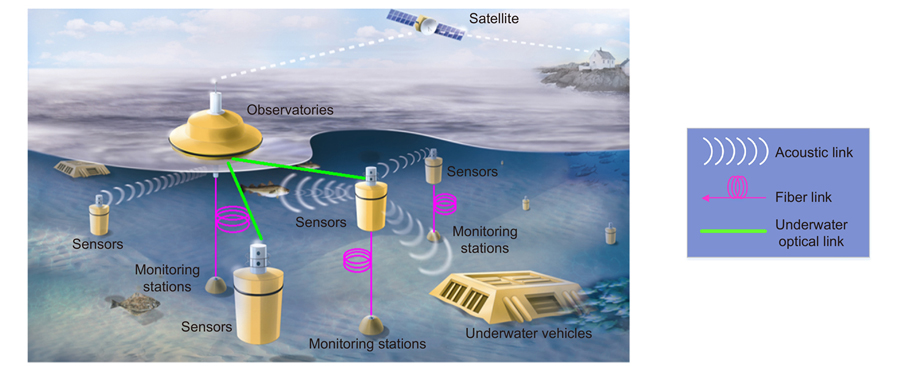光电工程, 2023, 50 (2): 220149, 网络出版: 2023-04-13
高精度水下激光频率传递研究进展
Progress on high-precision laser-based underwater frequency transfer
时间频率计量 水下频率传递 定时抖动抑制 相位补偿 metrology of time and frequency underwater frequency transfer timing fluctuation suppression phase compensation
摘要
相比于传统基于声纳、光缆的水下频率传递技术,水下激光频率传递技术具有更高的灵活性。本文首先介绍了水下激光频率传递技术的背景与意义,同时简要展示了国内外科研机构在水下激光频率传递方面的成果。然后,从理论上描述了水下链路特性的时域和频域特性,前者基于水体折射率微扰,后者基于柯尔莫哥洛夫大气湍流模型。接着,重点报道了电子科技大学在该领域的研究进展,包括电学相位补偿技术、光学相位补偿技术和多址频率分发技术。最后总结了这三类水下频率传递实验,对课题组在水下激光频率传递方面将要进行的工作进行了展望。作为具有较大潜力的水下频率传递技术,未来水下激光频率传递技术将在相关应用中发挥重要作用。
Abstract
Overview: Abundant resources in the ocean are not explored yet. The meaning of ocean exploration is far-reaching for the development of human society. In the future, the construction of underwater observation networks with outstanding performance is the precondition of a variety of scientific experiments, and time-frequency networks like GPS are helpful for the collaborative working of underwater platforms. The success of underwater wireless optical communication expands the dissemination of time-frequency signals over free-space and fiber links to underwater links. Compared with the conventional underwater frequency transfer methods, i.e. sonar, fiber links, and microwave method, the laser-based underwater frequency transfer owns strong competitiveness with the features of high flexibility, high bandwidth, and low latency. Such advantages make the laser-based underwater frequency transfer a promising approach for the construction of future underwater time-frequency networks. The paper introduces the progress on laser-based underwater frequency transfer at the University of Electronic Science and Technology of China, including the property analysis of underwater links, three specific techniques, and the future works that would be conducted. The property analysis of underwater links was conducted from the timing fluctuation attributed to refractive-index perturbation and underwater turbulence introduced power spectral density (PSD) that derived from the Kolmogorov model. The simulation results of Kolmogorov PSD and its modified PSD (von Kármán model) are given and analyzed. Based on the analysis, the experimental demonstrations of frequency transfer over 3 m, 6 m, and 9 m underwater links were conducted. The experimental results show that timing fluctuation is most partly attributed to underwater turbulence. It is necessary for highly stable frequency transfer to suppress timing fluctuation. An electronic phase compensation technique was employed for timing fluctuation suppression. A 100 MHz radio-frequency (RF) signal has been transferred over a 5 m underwater link using this technique. With the help of this technique, the root-mean-square (RMS) timing fluctuation was successfully suppressed from 9.6 ps to 2.1 ps within 5000 s. The noise, limited compensation bandwidth, and residual timing fluctuations of the electronic phase shifters block further improvement of system performance. Consequently, the optical delay line-based optical phase compensation technique was proposed and experimentally demonstrated. A 500 MHz RF signal was transferred over a 5 m underwater link for 5000 s, the RMS timing fluctuation was successfully suppressed from 7.3 ps to 0.162 ps. The experimental results show that the proposed technique could effectively suppress timing fluctuation and lower the system noise floor. Both phase compensation techniques are hard to support multiple-access frequency transfer because compensation configuration is included in the transmitter. A novel scheme for multiple-access frequency transfer was proposed and experimentally demonstrated. A 100 MHz RF signal was transferred over a 3 m underwater link for 5000 s, the RMS timing fluctuation was successfully suppressed from 73.4 ps to 3 ps. With this scheme, the phase of the frequency signal at multiple receivers could be simultaneously locked to the phase of the reference signal at the transmitter. In the future, the optical link of the multipleaccess frequency transfer experimental setup would be optimized for further performance improvement. Laser-based underwater frequency transfer experiments with picosecond-level timing fluctuations over hundred meters links would be demonstrated with the help of the single-photon detection technique and a picosecond mode-locked laser at 1064 nm wavelength.Inspired by underwater wireless optical communication, laser-based underwater frequency transfer technology extends frequency transfer and dissemination from fiber links and free-space links to underwater links and shows greater potential for applications. Compared with traditional underwater frequency transfer technologies (sonar, fiber links), laser-based underwater frequency transfer technology is more flexible and avoids the multipath effect and high latency. In the future, this technology is expected to contribute to the applications of underwater navigation and sensing, distributed observation networks, tracking and positioning systems, etc. This paper first introduces the background and significance of the underwater laser-based frequency transfer technique, and briefly shows the achievements of domestic and foreign scientific research institutions in underwater laser-based frequency transfer. Next, the paper presents the time domain and frequency domain descriptions of underwater link properties, in which the former is based on the refractive index perturbation of the water column and the latter is based on the Kolmogorov atmospheric turbulence model. Then, the research results of the University of Electronic Science and Technology in laser-based underwater frequency transfer are reported, including the electrical phase compensation technique, the optical phase compensation technique, and the multiple-access frequency dissemination technique. Finally, the three laser-based underwater frequency transfer experiments are summarized, and the future works of our group in laser-based underwater frequency transfer have been prospected. As a promising underwater frequency transfer technology, laser-based underwater frequency transfer technology will play a crucial role in relevant applications in the future.
侯冬, 任军委, 郭广坤, 刘科. 高精度水下激光频率传递研究进展[J]. 光电工程, 2023, 50(2): 220149. Dong Hou, Junwei Ren, Guangkun Guo, Ke Liu. Progress on high-precision laser-based underwater frequency transfer[J]. Opto-Electronic Engineering, 2023, 50(2): 220149.




